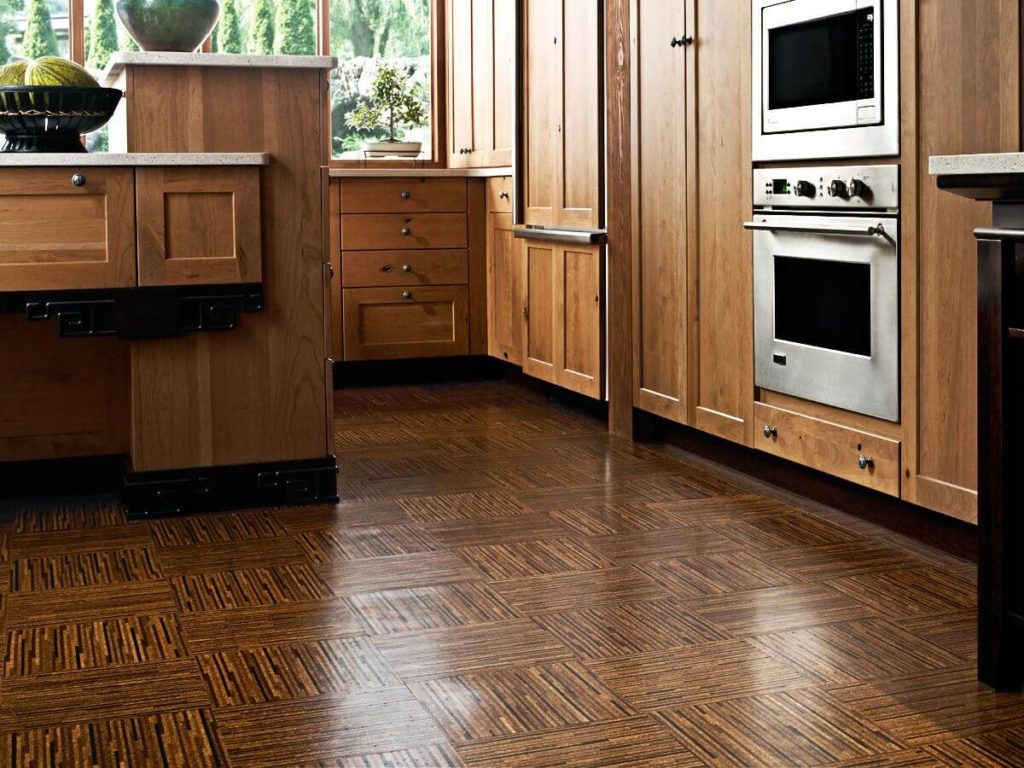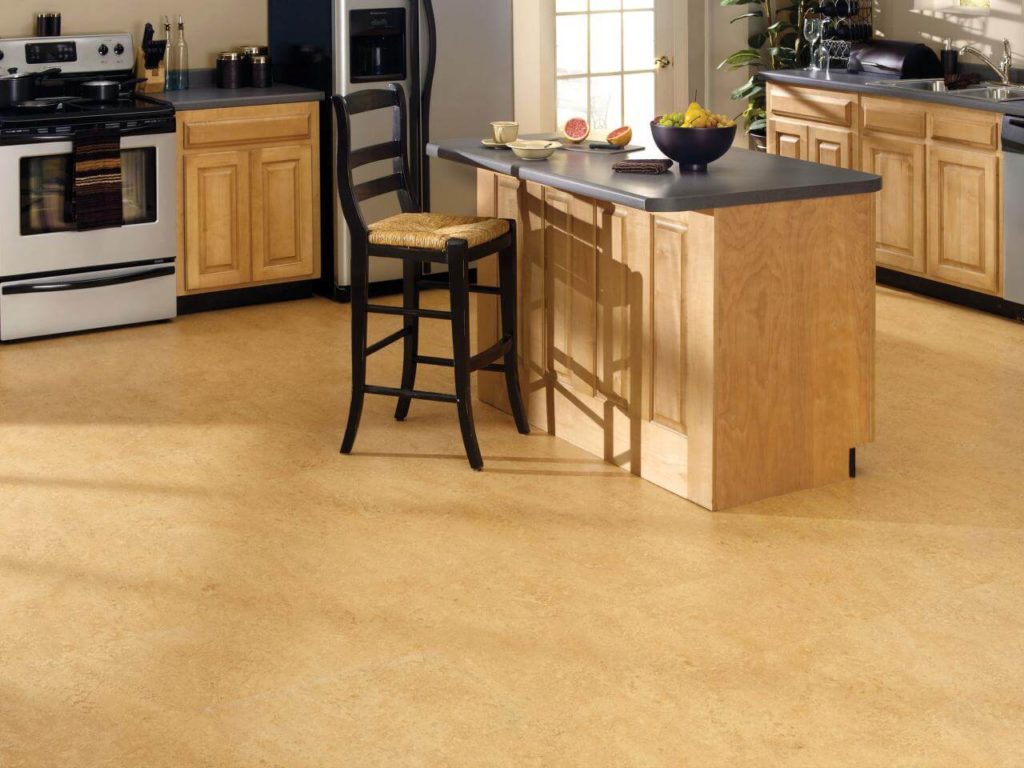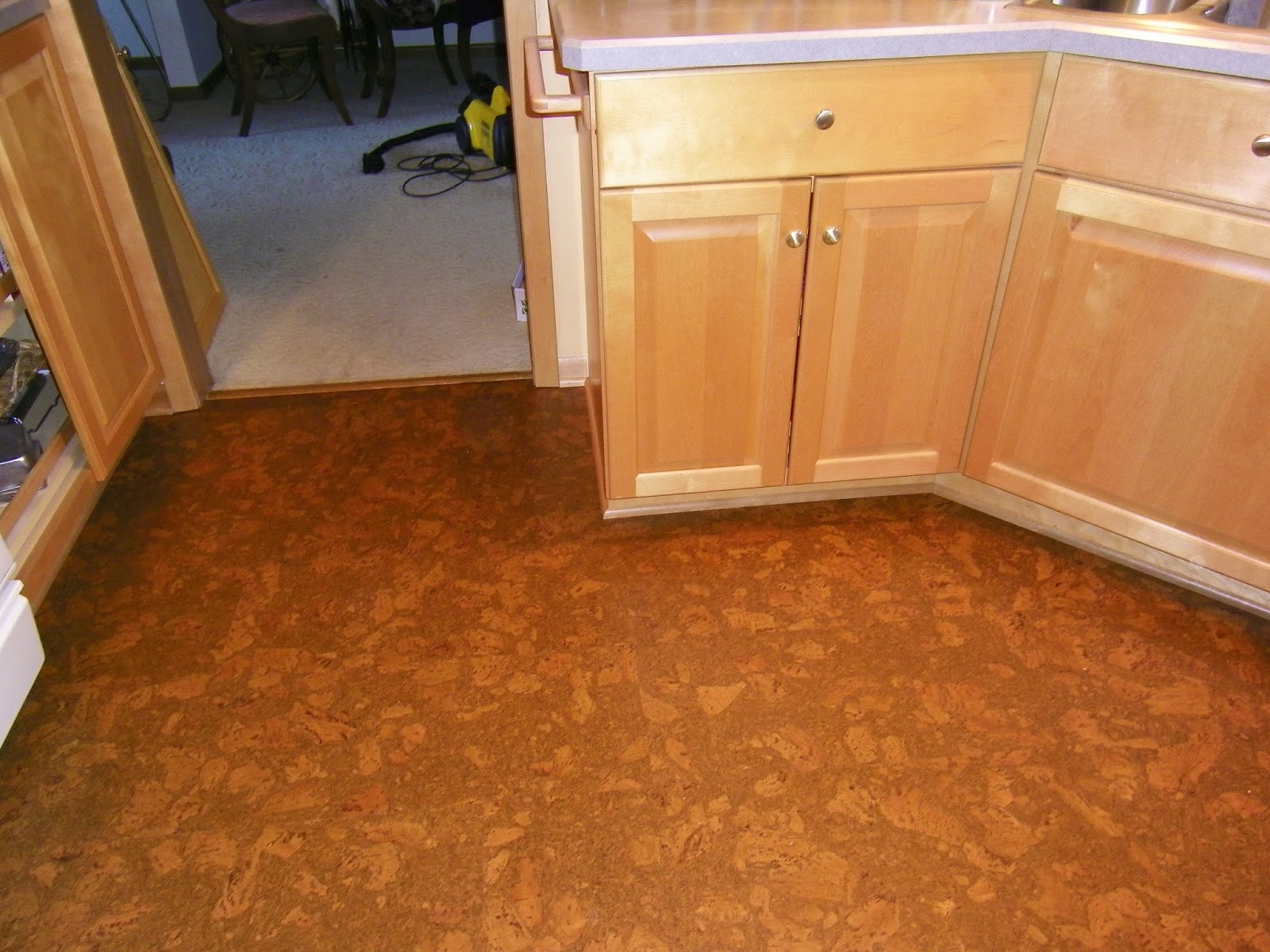Cork flooring is becoming an increasingly popular choice for kitchens due to its unique blend of comfort, sustainability, and style. If you’re considering cork flooring for your kitchen, it’s essential to understand its benefits, installation process, maintenance requirements, design options, and potential pitfalls. Let’s discuss everything you need to know about cork flooring in the kitchen.
Benefits of Cork Flooring in the Kitchen
- Comfort Underfoot: One of the standout benefits of cork flooring is its comfort. Cork has a natural elasticity that makes it soft and cushioned underfoot, which is especially beneficial in a kitchen where you might be standing for extended periods. This cushioning effect can reduce fatigue and make kitchen tasks more enjoyable. Additionally, cork has insulating properties, keeping your feet warm even on colder days.
- Eco-Friendly and Sustainable: Cork is a renewable resource harvested from the bark of cork oak trees without harming the tree. This makes it an environmentally friendly choice for flooring. The trees can live for centuries, and their bark regenerates after harvesting, ensuring a sustainable supply. Choosing cork flooring supports eco-friendly practices and reduces your carbon footprint.
- Durability and Resilience: Cork flooring is surprisingly durable and resilient, making it suitable for high-traffic areas like kitchens. Its natural composition allows it to withstand impacts and recover from minor indentations. This resilience means that cork flooring can maintain its appearance and functionality for many years, even in a busy household.
- Hypoallergenic and Healthy: For those with allergies, cork flooring is an excellent choice. It’s naturally resistant to mold, mildew, and termites, contributing to a healthier indoor environment. Cork does not release harmful chemicals and is free of volatile organic compounds (VOCs), ensuring better air quality in your kitchen.
- Acoustic Insulation: Cork’s cellular structure provides excellent acoustic insulation, reducing noise levels in your home. This is particularly beneficial in a kitchen, where the sounds of cooking and foot traffic can create a noisy environment. Cork flooring can help absorb sound, making your kitchen a quieter, more pleasant space.
- Aesthetic Appeal: Cork flooring offers a unique and attractive appearance that can enhance the aesthetic of any kitchen. It comes in a variety of colors, patterns, and textures, allowing you to choose a style that complements your kitchen design. Whether you prefer a natural look or a more contemporary finish, cork flooring can add warmth and character to your space.

Installation Process
Preparing the Subfloor
Proper subfloor preparation is crucial for a successful cork flooring installation. The subfloor must be clean, dry, and level. Remove any existing flooring and ensure that the surface is free of debris and imperfections. Address any cracks or uneven areas to create a smooth foundation for the cork tiles or planks.
Acclimating the Cork
Cork flooring needs to acclimate to the room’s temperature and humidity before installation. Lay the cork tiles or planks in the kitchen for at least 48 hours to adjust to the environment. This step helps prevent expansion or contraction after installation, ensuring a stable and lasting floor.
Laying the Underlayment
An underlayment is essential for cork flooring, providing additional cushioning and moisture protection. Choose an underlayment compatible with cork and roll it out over the subfloor. Secure it with adhesive or tape, ensuring there are no gaps or overlaps that could affect the flooring installation.
Installing Cork Tiles or Planks
There are two main types of cork flooring: glue-down tiles and floating planks. For glue-down tiles, apply a high-quality adhesive to the subfloor and carefully place each tile, pressing firmly to ensure good adhesion. For floating planks, connect the interlocking edges and lay them over the underlayment, leaving a small gap around the edges for expansion.
Cutting and Fitting
Measure and cut the cork tiles or planks to fit around cabinets, appliances, and other obstacles. Use a sharp utility knife for precise cuts, and ensure that the pieces fit snugly without gaps. Pay special attention to areas around doorways and transitions to other flooring types.
Sealing and Finishing
After installation, sealing the cork floor is essential to protect it from moisture and stains. Apply a water-based polyurethane sealant in multiple coats, allowing each coat to dry thoroughly. This sealing process enhances the durability and appearance of the cork flooring, ensuring it withstands the demands of a busy kitchen.
Maintenance Tips
Regular Cleaning
Keeping cork flooring clean is relatively easy. Regular sweeping or vacuuming helps remove dirt and debris that can scratch the surface. Use a vacuum with a soft brush attachment to avoid damaging the floor. For more thorough cleaning, use a damp mop with a mild detergent or a cleaner specifically designed for cork flooring.
Preventing Scratches and Damage
Preventing scratches and damage is crucial for maintaining the appearance of cork flooring. Place mats or rugs at entryways to catch dirt and grit that could scratch the floor. Use felt pads under furniture legs to prevent scratches when moving them. Avoid dragging heavy objects across the floor, as this can cause significant damage.
Dealing with Spills and Stains
Cork flooring is water-resistant but not waterproof, so it’s important to clean up spills promptly. Wipe up any liquid with a soft, dry cloth to prevent moisture from seeping into the seams. For tougher stains, use a gentle cleaner and avoid harsh chemicals that could damage the finish.
Regular Sealing
Sealing cork flooring periodically helps maintain its durability and appearance. Depending on the level of traffic and wear, reseal the floor every few years with a water-based polyurethane sealant. Regular sealing protects the cork from moisture and stains, extending its lifespan and keeping it looking fresh.
Repairing Minor Damages
Minor damages like small scratches or dents can often be repaired with a cork repair kit. These kits typically include a filler and colorant to match the floor. For larger damages, you may need to replace the affected tiles or planks. Keeping spare cork pieces from the original installation can make this process easier.
Long-Term Care
Long-term care of cork flooring involves regular cleaning, prompt spill cleanup, and periodic resealing. By following these maintenance tips, you can ensure that your cork floor remains in excellent condition for many years. Regularly inspect the floor for signs of wear or damage and address any issues promptly to prevent further deterioration.
Design Options
Color Variations
Cork flooring comes in a wide range of colors, from natural hues to more vibrant tones. You can choose a color that complements your kitchen’s overall design. Natural cork colors like honey, caramel, and espresso offer a warm, earthy look, while dyed cork can add a pop of color to your space.
Patterns and Textures
Cork flooring is available in various patterns and textures, allowing you to create a unique and visually appealing kitchen floor. Popular patterns include geometric designs, abstract motifs, and wood-grain looks. Textured cork can mimic the appearance of other materials like stone or hardwood, providing aesthetic versatility.
Tile and Plank Sizes
Cork flooring is available in different tile and plank sizes, giving you flexibility in design. Standard square tiles and rectangular planks are common, but you can also find hexagonal and other unique shapes. Mixing different sizes can create a dynamic and interesting floor pattern that enhances your kitchen’s design.
Finishes
Cork flooring can be finished in various ways to achieve different looks. Matte finishes provide a natural, understated appearance, while glossy finishes add a touch of elegance and make the floor more reflective. Semi-gloss finishes offer a balance between the two, providing a slight sheen without being too reflective.
Custom Designs
For a truly personalized look, consider custom-designed cork flooring. Many manufacturers offer the option to create bespoke tiles or planks tailored to your specific design preferences. This can include custom colors, patterns, and sizes, allowing you to achieve a one-of-a-kind floor that reflects your style.
Combining Cork with Other Materials
Combining cork flooring with other materials can create a unique and stylish kitchen floor. For example, pairing cork tiles with ceramic or natural stone can add texture and visual interest. This combination can also provide practical benefits, such as using more durable materials in high-traffic areas and softer cork in areas where comfort is a priority.
Common Mistakes to Avoid
Improper Subfloor Preparation
Skipping proper subfloor preparation is a common mistake that can lead to issues with cork flooring. Ensure the subfloor is clean, dry, and level before installation. Any imperfections in the subfloor can cause the cork tiles or planks to shift or crack, compromising the integrity of the floor.
Incorrect Adhesive Use
Using the wrong adhesive can result in poor adhesion and potential floor failure. Always use an adhesive specifically designed for cork flooring and follow the manufacturer’s instructions. The correct adhesive ensures that the cork tiles or planks stay securely in place and perform well over time.
Neglecting Acclimation
Failing to acclimate cork flooring to the room’s temperature and humidity can cause expansion or contraction after installation. Allow the cork tiles or planks to acclimate for at least 48 hours in the kitchen. This step is crucial for ensuring a stable and lasting installation.
Ignoring Sealing Requirements
Not sealing cork flooring properly can leave it vulnerable to moisture and stains. Always apply a water-based polyurethane sealant after installation and reseal the floor periodically. Proper sealing protects the cork and extends its lifespan, keeping it looking good and performing well.
Using Harsh Cleaners
Using harsh or abrasive cleaners can damage the finish of cork flooring. Stick to mild detergents or cleaners specifically designed for cork. Harsh chemicals can strip the sealant and damage the cork, leading to a shorter lifespan and a less attractive appearance.
Overlooking Maintenance
Neglecting regular maintenance can lead to a buildup of dirt and damage over time. Regularly sweep, mop, and reseal your cork floor to keep it in optimal condition. Overlooking maintenance can diminish the durability and aesthetic appeal of your cork flooring, requiring more frequent repairs or replacements.
Is Cork Flooring Durable Enough for Kitchens?
Cork flooring is durable enough for kitchens, thanks to its resilience and ability to withstand impacts. Its natural elasticity allows it to recover from minor indentations, making it suitable for high-traffic areas. However, proper installation, sealing, and maintenance are crucial to ensure its longevity in a kitchen environment.
How Do I Clean and Maintain Cork Flooring in the Kitchen?
Cleaning and maintaining cork flooring is straightforward. Regularly sweep or vacuum to remove dirt and debris. Mop with a damp cloth and a mild detergent or a cleaner designed for cork. Avoid using harsh chemicals or abrasive cleaners. Periodically reseal the floor to protect it from moisture and stains, ensuring it stays in excellent condition.
Can Cork Flooring Handle Moisture in the Kitchen?
Cork flooring is water-resistant but not waterproof, so it can handle some moisture. However, it’s essential to clean up spills promptly to prevent water from seeping into the seams. Sealing the floor adds an extra layer of protection against moisture. For kitchens, where water exposure is common, proper sealing and maintenance are vital to prevent damage.
What Are the Aesthetic Options for Cork Flooring?
Cork flooring offers a wide range of aesthetic options, including various colors, patterns, textures, and finishes. You can choose from natural hues or dyed cork to match your kitchen design. Patterns can range from simple to intricate, and finishes can be matte, semi-gloss, or glossy. Custom designs are also available for a personalized look.
How Is Cork Flooring Installed in the Kitchen?
Cork flooring can be installed using glue-down tiles or floating planks. Proper subfloor preparation is essential, ensuring it is clean, dry, and level. Cork must acclimate to the room before installation. For glue-down tiles, a specific adhesive is used, while floating planks are connected and laid over an underlayment. Sealing the floor after installation is crucial for protection.
What Are the Environmental Benefits of Cork Flooring?
Cork flooring is an eco-friendly choice due to its sustainable harvesting process. Cork is obtained from the bark of cork oak trees, which regenerate their bark, making it a renewable resource. Choosing cork supports sustainable practices and reduces environmental impact. Additionally, cork flooring can improve indoor air quality as it is free of VOCs and other harmful chemicals
Cork Flooring Kitchen Pros and Cons
Kitchen with cork flooring Kitchen flooring
Maximizing Cork Flooring for Kitchen
Related Posts:











